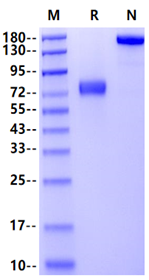Ala23-Asp309, with C-terminal Human IgG1 Fc AEPHSLRYNLMVLSQDGSVQSGFLAEGHLDGQPFLRYDRQKRRAKPQGQWAENVLGAKTWDTETEDLTENGQDLRRTLTHIKDQKGGLHSLQEIRVCEIHEDSSTRGSRHFYYDGELFLSQNLETQESTVPQSSRAQTLAMNVTNFWKEDAMKTKTHYRAMQADCLQKLQRYLKSGVAIRRTVPPMVNVTCSEVSEGNITVTCRASSFYPRNITLTWRQDGVSLSHNTQQWGDVLPDGNGTYQTWVATRIRQGEEQRFTCYMEHSGNHGTHPVPSGKALVLQSQRTDIEGRMDPKSSDKTHTCPPCPAPELLGGPSVFLFPPKPKDTLMISRTPEVTCVVVDVSHEDPEVKFNWYVDGVEVHNAKTKPREEQYNSTYRVVSVLTVLHQDWLNGKEYKCKVSNKALPAPIEKTISKAKGQPREPQVYTLPPSRDELTKNQVSLTCLVKGFYPSDIAVEWESNGQPENNYKTTPPVLDSDGSFFLYSKLTVDKSRWQQGNVFSCSVMHEALHNHYTQKSLSLSPGK
1. Gene ID: 4277, updated on 21-Jun-2023.
MICB is a ligand for the NKG2D type II receptor. Binding of the ligand activates the cytolytic response of natural killer (NK) cells, CD8 alphabeta T cells, and gammadelta T cells which express the receptor. Similar to classical MHC class I proteins, MICB contains three Ig-like domains ( alpha 1, alpha 2, and alpha 3) in the extracellular domain (ECD), a transmembrane segment, and a carboxy-terminal cytoplasmic tail.MICB is minimally expressed on normal cells, but are frequently expressed on epithelial tumors and can be induced by bacterial and viral infections.

1ug (R: reducing conditions, N: non-reducing conditions).